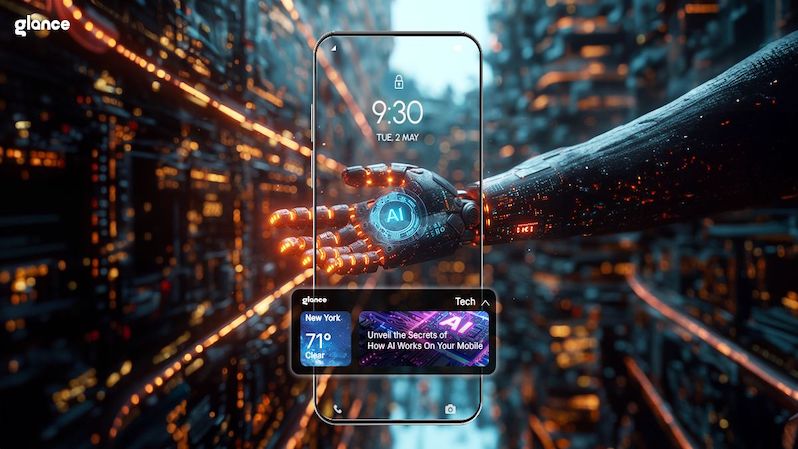5 Ways AI Is Making Your Smartphone Even Smarter

As phones shift from basic to brilliant, this tech expert says the new era of AI is the gateway for next‑level devices.
Remember when phones were just, well, phones? You could make a call, send a few texts (minus the emojis, ugh), and maybe play a game of Snake. Since that time, smartphones have evolved into supercomputers that live in your pocket, with the power to unlock your car, adjust your thermostat, suggest recipes based on what’s in your fridge and way more.
With exciting new devices that recently dropped, we asked Andre Najee, a cybersecurity specialist, content creator and tech enthusiast, to help break down the five ways artificial intelligence, combined with the power of 5G, has completely transformed smartphones — making them smarter, more personal and straight-up essential.
Your Phone, Your Way
AI is all about personalization and making your phone work seamlessly for you. It learns from your habits, adapts to how you use it, and even optimizes battery life for the things that matter most. As a result, Najee says your device can anticipate your needs before you even ask.
“Through learning your daily patterns, your phone is able to recommend apps you commonly use in your morning routine or highlight content that might be of interest to you,” says Najee. “This creates a more intuitive and engaging experience and allows smartphones to adjust to your preferences.”
The benefits of these AI features that are useful for everyday habits also trickle down to convenience and increased productivity, Najee says.
“Most modern smartphones use some form of AI and machine learning to analyze how we communicate with each other, like drawing conclusions to recommend the next word in a text message or the next sentence in an email,” he says. “These systems learn and adapt over time so recommended responses between contacts can be different, which is useful when you’re sending messages to a friend versus someone like your supervisor.”
Next-Level Accessibility and Inclusivity
AI is making phones more accessible than ever, with tools like voice commands and speech-to-text empowering people to communicate and navigate the world more easily. By 2027, the global assistive tech market is set to hit over $27 billion, with AI driving much of this change.
As Najee notes, “AI has been incorporated into many accessibility features to make smartphones more efficient and effective in providing a user-friendly experience. Features like real-time voice transcription, image recognition for the visually impaired and voice-command-based navigation would not be possible without AI.”
AI is also driving real-time translation tools, breaking down communication barriers between languages. For example, Google Translate now supports over 240 languages with near-instant speech-to-text translation powered by AI, making cross-language communication seamless.
Smartphones can now even support multi-language keyboards so you can adapt it for your needs effortlessly. Learn how to activate multi-language keyboards with this episode of T-Mobile’s “Ask a Mobile Expert,” and then, rely on AI to enhance the experience by providing predictive text, smooth language switching and contextual suggestions.
Cameras That Are Basically Magic
Gone are the days of blurry pics and missing the perfect moment. The AI-powered cameras on today’s smartphones leverage advanced software that helps people capture images that were once only possible with professional equipment.
For instance, AI can detect the difference between the subject and the background to create perfect portrait-mode shots that rival high-end cameras. So whether you’re taking a group photo at a dimly lit concert or trying to capture the perfect sunset selfie, AI adjusts the camera settings for the ideal exposure and clarity.
AI also steps in after the shot, sharpening details and boosting colors to make sure every photo pops. Features like real-time image enhancement and scene recognition help you capture those epic, Insta-worthy shots even with zero photography skills.
Always-On Security
In a world full of hackers and scammers, you need your phone to have your back 24/7. AI is helping to make sure that’s the case.
“AI has helped improve smartphone security features, and biometric authentication is a great example,” says Najee. “Through pattern recognition and computer vision, AI has enhanced the accuracy of facial recognition and fingerprint scanning systems, making them faster, more reliable and more secure. This technology allows systems to more effectively differentiate between genuine biometrics and fraudulent attempts.”
And for T-Mobile customers, Scam Shield offers an additional layer of protection. This AI-powered feature blocks millions of scam calls every day, shielding you from those annoying robocalls before they even reach you.
Virtual Assistants That Get You
Virtual assistants have transformed from cool features into must-haves. By 2022, 142 million people — nearly half the U.S. population — were using them, with that number expected to hit 157 million by 2026. Powered by AI, these assistants understand natural language and anticipate your needs from learning your behaviors. They’re personal assistants who are always ready to help you send a text, control smart home devices or provide directions. Need to set a reminder or make a call while driving? Just ask, hands-free.
And now, virtual assistants are only getting smarter with new AI-enabled devices. Soon, some will even be able to understand personal context. So, if you're searching for a recipe shared via text, note or email, or need your passport number for booking a flight, it can quickly locate the information on your device — which is far more complex than simply answering, “What’s the weather today?”
And while smartphones with AI capabilities continue to advance, people can get the best experience only on America’s largest, fastest and most awarded 5G network.
“AI has allowed smartphones to live up to their name,” said Najee. “They’ve become devices that actually feel intelligent. This has an impact on both how we use our devices to be more productive every day as they become true extensions of us and our capabilities.”

